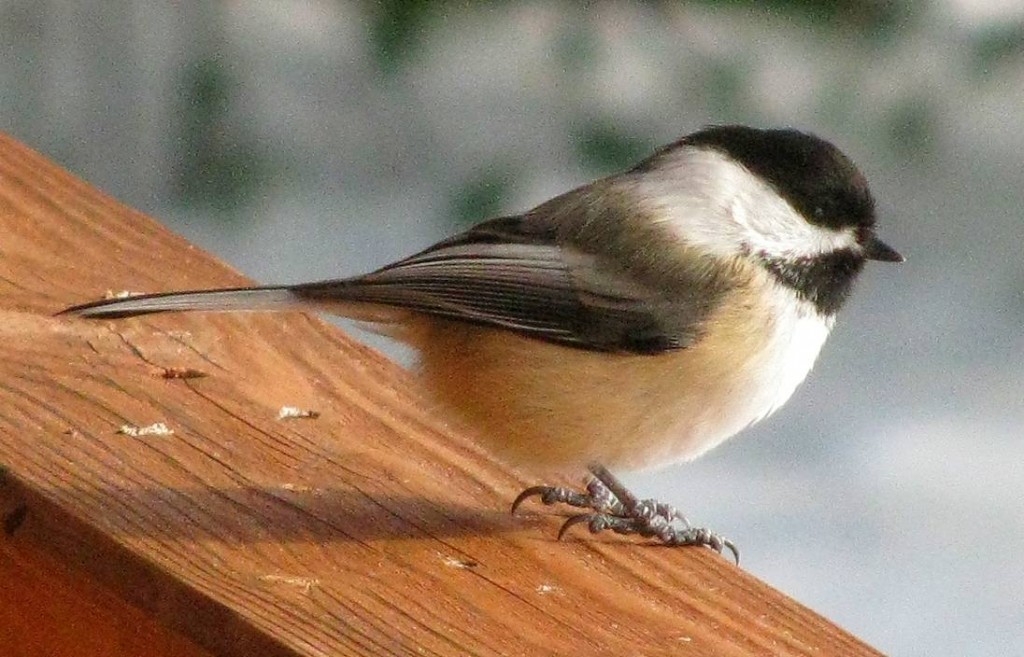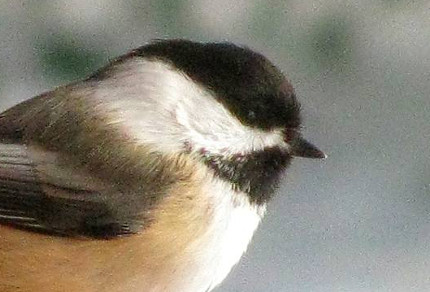
Winter on Matheson Brook, Nova Scotia (© Magi Nams)
This morning, I walked with Pepper in calm, still cold before sunrise, the -15°C air fresh and biting. New snow blanketed our access road, the white stuff embossed with amorphous hollows created by clods of snow fallen from hemlocks and by the tracks of deer mice, ermine, and a canid that I guessed was either a large fox or small coyote. The canid tracks were dusted with snow and indistinct, but the deer mice tracks clearly indicated the small rodents’ hops and tail drag marks, while the ermine trail displayed neat side-by-side footprints spaced by long gaps. I saw where the ermine had disappeared into a hole in the snow and suspected that it had been hunting deer mice and other rodents.

Black-capped Chickadee (© Magi Nams)
The woods were silent, no bird voices claiming territories or challenging intruders. In our yard, however, black-capped chickadees chirped, dark-eyed juncos flitted between a windbreak of spruces and our bird feeder, and blue jays voiced ringing calls and evicted small birds from the feeder. A week ago yesterday, I heard for the first time this year the mating call of the black-capped chickadee, affectionately known in Nova Scotia as the ‘cheeseburger’ bird since that’s what its mating call seems to be saying. Chickadees, blue jays, and great horned owls are three of our resident birds which get a head start on the breeding season long before warblers, hummingbirds, and other migratory birds arrive from their wintering grounds to the south. So, even though the Nova Scotian winter will linger for at least two more months, my thoughts have been turning to spring, to pruning my grapes, and to those heart-lifting first songs of breeding birds.
On the topic of birds, my post today shares links for three intriguing videos of bird behaviour. While living in Australia, I joined the Townsville Region Bird Observers Club, which is now known as BirdLife Townsville. Since returning to Canada, I’ve remained in contact with the club and receive all sorts of club notices that remind me of excursions I enjoyed in the Townsville area with the club, and also links to various video clips, including the ones I’m sharing today.
Just this morning, I received one of these clips, which documents in slow motion the flight of a northern goshawk through small holes and a tunnel, these apertures in a solid wall representing the confined spaces between trees and branches a goshawk encounters in its daily hunts for prey. The video is stunning, and the goshawk Ellie fabulously beautiful. I’ve seen northern goshawks skimming along the edge of our woods, and one autumn Vilis, our sons, and I crept to the edge of our chicken coop to watch a goshawk eat one of our chickens it had killed back of the coop. Raising free range chickens in goshawk territory is a risky endeavour. Here’s the link for Ellie.
The second clip features an unidentified corvid that could audition for the role of an avian McIver. The bird’s cleverness at improvising a hook to retrieve a food bucket from a glass tube is astounding. If you’ve never experienced a brainy corvid first hand, let me tell you that the these birds (crows, ravens, jays) are remarkable in their persistence and ingenuity. Last summer, I protected my ripening sweet cherries with bird netting, tying the plastic mesh over the two trees and ‘sewing’ the loose edges together to bring the netting snugly against the trees’ trunks. As soon as the netting went on, American robins gave up trying to steal my cherries. Our resident blue jays did not. One particular bird mangaged to find a small gap in the netting near one tree’s trunk and repeatedly flew up from the ground, squeezed through the gap, and into its own private banquet of cherries. No matter how small I made the gap, which occurred because of forking branches and thus could not be entirely eliminated, the jay searched for the hole, looking up from ground level beneath the tree, and then pushed its way through the gap. It was, however, not as skilled at finding its way out, and on several occasions flopped around inside the netting for several minutes before exiting it. Fortunately, it never figured out how to get at the second tree’s crop of cherries.
The third clip features two unlikely buddies, a barn owl and a cat, at play. It’s a whole new take on The Owl and the Pussycat. Enjoy!


